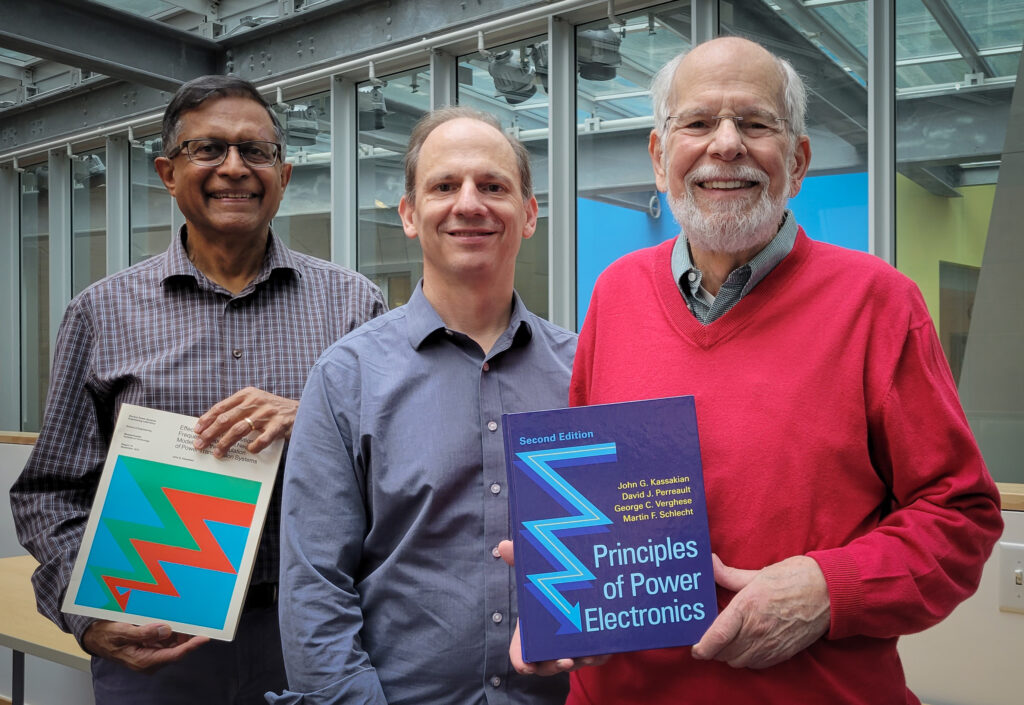“Principles of Power Electronics” meets a milestone
 From left to right: George Verghese, David Perreault, John Kassakian. Photo credit: Jane Halpern
From left to right: George Verghese, David Perreault, John Kassakian. Photo credit: Jane Halpern Past and present students of 6.334 “Power Electronics” will recognize this title, which recently hit a significant milestone. Professors George Verghese, David Perreault, and John Kassakian (left to right) gathered for a photo with the second edition of Principles of Power Electronics, just published by Cambridge University Press, 32 years after the first edition! The modernized and expanded edition of the classic textbook has a snazzy new cover design, inspired by the “shazam” logo of MIT’s former Electric Power Systems Engineering Laboratory (EPSEL), seen here on the cover of Kassakian’s PhD thesis (held by Verghese).
Kassakian formed the nucleus of the group of co-authors in many ways. Verghese notes that his own area of research when he joined the MIT faculty in 1979 was quite different, but Kassakian took him under his wing, introduced him to power electronics and to the affiliated community, as well as to his doctoral student, Martin Schlecht. “I learned what I know about power electronics from Marty and John,” says Verghese, who teamed up with both a decade later to co-author the first edition of the text. Schlecht subsequently joined the EECS faculty, leaving fifteen years later to found SynQor.
Dr. Emmanuel E. Landsman ’58, SM ’59, ScD ’66, and the co-founder of American Power Conversion in 1981, shared his experience designing and building the power converters for communications satellites at Lincoln Lab in the late 70’s. “It was the early days of switching power, with few resources to consult. … [T]echnical articles … did not supply all the answers that I needed. I started to do my own derivation of the small-signal dynamics [of power converters], deriving functions that were close enough to design appropriate compensators to acceptably stabilize the converters with good dynamic regulation.” Clearly, the time was ripe for a more complete treatment of the subject. Referring to the first edition, Landsman added: “This book covered all the dynamic transfer functions that would have saved immense time for me and might have influenced me to change my designs to improve the function of these satellites.” Some of Landsman’s early contributions to power electronics are reflected in both editions of the book, and his support was instrumental in the preparation of the second edition,
Robert White ‘80, who founded Embedded Power Labs in 2009, remembered a time when the entire concept of “power electronics” was considered a niche interest. “I took 6.334 before even the first edition was notes (spring of 1979). George Verghese, along with Marty Schlecht and Neil Rasmussen, were my fellow classmates. Emanuel “Manny” Landsman sat in and provided some additional discussion and commentary.”

“Very interesting that the power electronics class evolved quickly from this syllabus of a special topics class (6.975) to a regular class (6.334) by the time I took it a few years later,” White mused, adding: “I have had a very nice career in power electronics thanks in large part to Professor Kassakian. I was not a particularly distinguished student, graduating with a B average. I received a perfect score on the final exam in 6.334 – probably the only perfect score on any exam I took at MIT. I knew I had found my calling. Professor Kassakian then invited me to participate in a graduate special topics class with many of the same students as 6.334. We worked on designing the power train and controls for an electric vehicle. I recall one meeting of that class was at Manny Landsman’s home, sitting around his dining room table discussing the design of the power electronics for the electric vehicle.”
The enthusiasm and commitment of those early power electronics students within MIT was infectious. Of Kassakian’s former students, several became power electronics faculty themselves, using the first edition of the book as a touchstone for their courses. The field’s growth has continued to outpace all expectations, and by the 2020s a major update was due. David Perreault—another former doctoral advisee of Kassakian’s who subsequently joined the EECS faculty, and has been at the forefront of many exciting later developments in the field—signed on to help tackle the imposing challenge of writing a second edition of the now-classic book. The second edition greatly expands upon the first, and weighs in at a hefty 4.6 pounds and 800 pages–a reflection of the increased stature and importance of power electronics to a whole new generation of electrical and computer engineers. The new edition has been warmly received, with early reviewers applauding how the authors “have thoroughly brought the book’s core contents up to date, and expanded its coverage” (Thomas Jahns, University of Wisconsin–Madison), calling it “an excellent text for a foundational course in power electronics” (Khurram Afridi, Cornell University) and “a must for anyone in the field of power electronics” (Gerard Hurley, University of Galway).
For their part, the coauthors credit and thank their students, and the entire EECS community, in the clearly heartfelt final paragraph of the book’s acknowledgements: “All four of us have had the good fortune to be shaped in fundamental ways, as students and professors, by MIT’s stellar and lively Department of Electrical Engineering and Computer Science. Being part of this community for a combined total of more than 15 decades has been such a privilege, and we have gained more there than we could ever repay. Perhaps with this book we can pay some portion of our debt forward.”
Media Inquiries
Journalists seeking information about EECS, or interviews with EECS faculty members, should email eecs-communications@mit.edu.
Please note: The EECS Communications Office only handles media inquiries related to MIT’s Department of Electrical Engineering & Computer Science. Please visit other school, department, laboratory, or center websites to locate their dedicated media-relations teams.